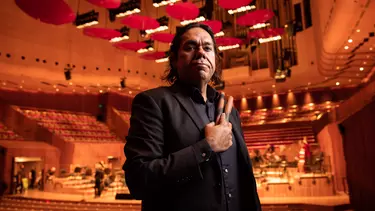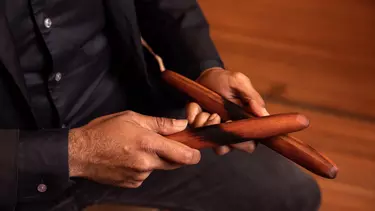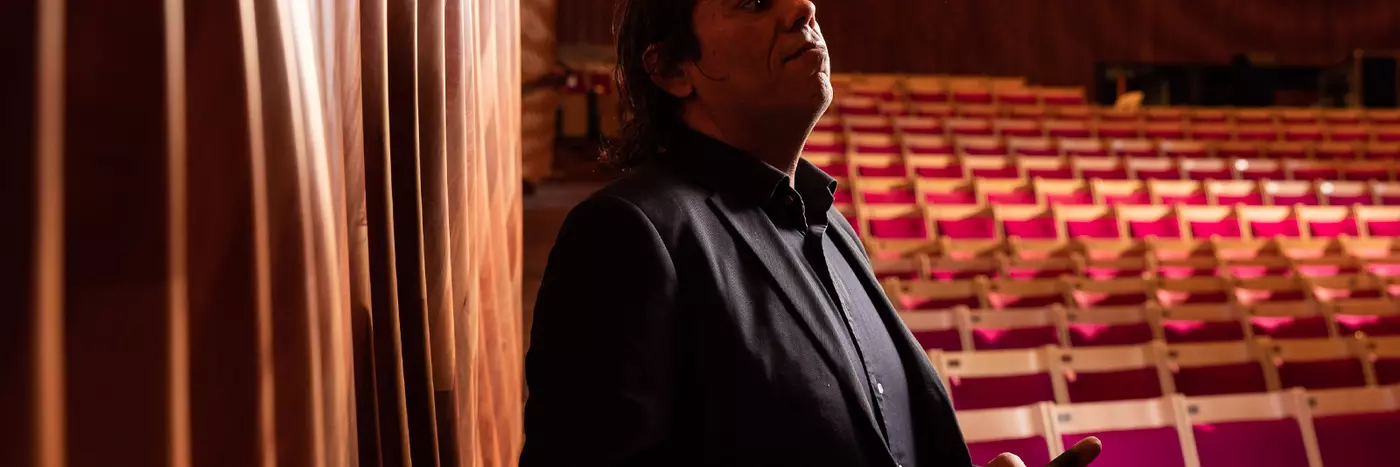“Rebirth and resurrection”
William Barton is welcoming us back to the Concert Hall
William Barton has played the Sydney Opera House Concert Hall more times than he can count.
“I had a figure in my head some years ago and I blurted out 300 but that was a long time ago,” he says.
Since he joined his first orchestra as a soloist at the age 17, the Kalkadunga man and award-winning composer and didgeridoo player has gone on to perform on some of the most prestigious stages of the world, but the Concert Hall holds a special place.
“It's my stomping ground, of late,” he says, “my second home apart from the natural amphitheatre of the Australian bushland.”
So it is fitting that his brand new composition, Of the Earth, should be the first to greet audiences as the Concert Hall makes a triumphant return after closing for more than two years for state-of-the-art upgrades.
Commissioned as part of the Sydney Symphony’s 50 Fanfares project, this world premiere will precede Mahler’s monumental Second Symphony (popularly known as the ‘Resurrection’ Symphony) in Simone Young conducts Mahler 2 (20-24 July) – a program that sees Resident Company Sydney Symphony Orchestra make their return to the renewed venue, and celebrates Australian-born, globally renowned artist Simone Young’s debut as the Orchestra’s Chief Conductor.

It’s a significant event for the composer, who first envisioned the potential of melding the ancient sounds of Australia with the classical old world sounds of Europe when he was a teenager.
“You need the full sonic force of a symphony orchestra and all those other little elements in between to interpret the complexities of the Australian bushland even though it is so simple and beautiful as well,” he says.
“Classical music is comparatively young here in this country, and we’ve got our own lineage of music as Indigenous people so what I hope I bring is an interpretation of the vastness of the Australian landscape.”
William has yet to visit the completed hall, but members of the Orchestra have begun rehearsals and Concertmaster Andrew Haveron says the new hall is “better than anything we could have hoped for. Better, actually, than anything we dared imagine. You can hear every minute detail now … right up to the back row. It’s a miracle”.
In a career of groundbreaking and innovative works, Of the Earth, performed in his traditional language, is perhaps William’s most ambitious. He is looking forward to hearing it brought to life by Australia’s premier orchestra accompanied by all the might of the combined Sydney Philharmonia Choirs and Gondwana Indigenous Children’s Choir, and seeing “how people can better hear in finer detail all these other nuances that audiences struggled to hear before in the Concert Hall”.
The work, he says, is “about rebirth and resurrection and how important language is as a part of our nations, and how we have to pass that on to the next generation of storytellers”.

But he also wants to acknowledge that just as the Concert Hall can be seen as a sacred space for western society, “there's a sacred space outside the Opera House too” – Tubowgule, the land on which the Opera House stands, which was once a place of gathering and celebration for the Gadigal people of the Eora nation.
For the choristers, William has had some 60 pairs of clapsticks made, using wood salvaged from the Concert Hall’s old and new stages. These simple percussive instruments are an intrinsic part of William’s cultural heritage, and in crafting them from the hall’s old floorboards, they become avatars of the Sydney Opera House’s own heritage and a tribute to the thousands of performers that have come before and the thousands more to come.
“The floorboards are very significant and part of actual history – to have that wood and have kids play it, that's a form of spiritual journey,” he says.
Inclusivity and environmental sustainability are fundamental to this journey and reflect the Sydney Opera House’s commitment to the UN’s Global Goals, which are dedicated to creating a better world for future generations.
To source the wood for the clapsticks, William visited the Sydney Opera House’s vast storage facility where construction material is warehoused for repurposing or recycling – in the 21-22 financial year, 90% of materials for its renewal projects were recycled.
It was here that he found the warm timber of the brushbox tree, a feature of the Concert Hall for the past 50 years, that would find new life in the hands of the choristers performing his new work.
“They're being made by professional luthiers, and I’ve got Aboriginal brothers making them as well,” he says. “The whole purpose was to have white and black – to be very blunt – of a certain lineage, creating these instruments as part of the old for the new. It’s very ceremonious.
“I wanted them to be all different and I wanted them to be mixed up in terms of who has clapsticks made from the floorboards from the choir stalls to the main stage to who made it – whether it was the Aboriginal guy or the luthier.”
“I want people to feel that they're holding a part of history but they're also as important as the next person to them.”
When William joined the Queensland Symphony Orchestra as a teenager, pairing a didgeridoo with an orchestra was, he says, “uncharted territory”. But he had grown up surrounded by the classical music so loved by his mother, Delmae, herself a singer and poet, and had already been playing the didgeridoo for a decade. He knew what was possible, and if others could not yet see it, he was ready to show them.
Since then, William’s imagination and virtuosity on multiple instruments has seen him occupy a peerless space in Australian culture, gaining industry acclaim, winning awards and performing in the world’s historic concert halls, as well as becoming a creative consultant for the Australia Day Live celebrations in the Sydney Opera House Forecourt.
Decades later, he looks back on his journey from Mt Isa, proud of what he has achieved, but with an eye on what more he can do.
“You have certain milestones in your life and I feel now, as a 41-year-old, I’ve got the next – hopefully! – 40 years to look at in shaping the next journey. What can I make better? How can I become a better musician?”
Right now though, his second home is waiting, its new stage the perfect platform for a giant of Australian music; its new acoustics ready to reveal every wondrous detail of his new masterpiece, his song to country, community, and rebirth.
